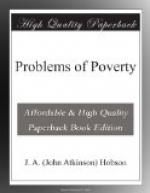What these figures mean is that almost the whole of the natural increase in country population is being gradually sucked into city life. Not London alone, of course, but all the large cities have been engaged in this work of absorption. Everywhere the centripetal forces are at work. The larger the town the stronger the power of suction, and the wider the area over which the attraction extends. There are three chief considerations which affect the force with which the attraction of a large city acts upon rural districts. The first is distance. By far the largest quantity of new-comers into London are natives of Middlesex, Kent, Bucks, and what are known as “the home counties.” As we pass further North and West, the per-centage gradually though not quite regularly declines. The numbers from Durham and Northumberland on the one hand, and from Devon and Somerset on the other are much larger than those from certain nearer counties, such as Stafford, Yorkshire, and Lancaster. The chief determinate of the force of attraction, distance from the centre, is in these cases qualified by two other considerations. In the case of Durham and Northumberland a large navigable seaboard affords greater facility and cheapness of transport, an important factor in the mobility of labour. In the case of Devon and Somerset the absence of the counter-attraction of large provincial cities drives almost the whole of its migratory folk to London, whereas in Yorkshire and Lancashire and the chief Midland manufacturing counties the attraction of their own industrial centres acts more powerfully in their immediate neighbourhood than the magic of London itself. Thus, if we were to take the map of England and mark it so as to represent the gravitation towards cities, we should find that every remotest village was subject to a number of weaker or stronger, nearer or more distant, forces, which were helping to draw off its rising population into the eddy of city life. If we examined in detail a typical agricultural county, we should probably find that while its one or two considerable towns of 40,000 or 50,000 inhabitants were growing at something above the average rate for the whole country, the smaller towns of 5000 to 10,000 were only just managing to hold their own, the smallest towns and large villages were steadily declining, while the scattered agricultural population remained almost stationary. For it is the small towns and the villages that suffer most, for reasons which will shortly appear.
Sec. 3. Effects of Agricultural Depression.—We have next to ask what is the nature of this attractive force which drains the country to feed the city population? What has hitherto been spoken of as a single force will be seen to be a complex of several forces, different in kind, acting conjointly to produce the same result.




